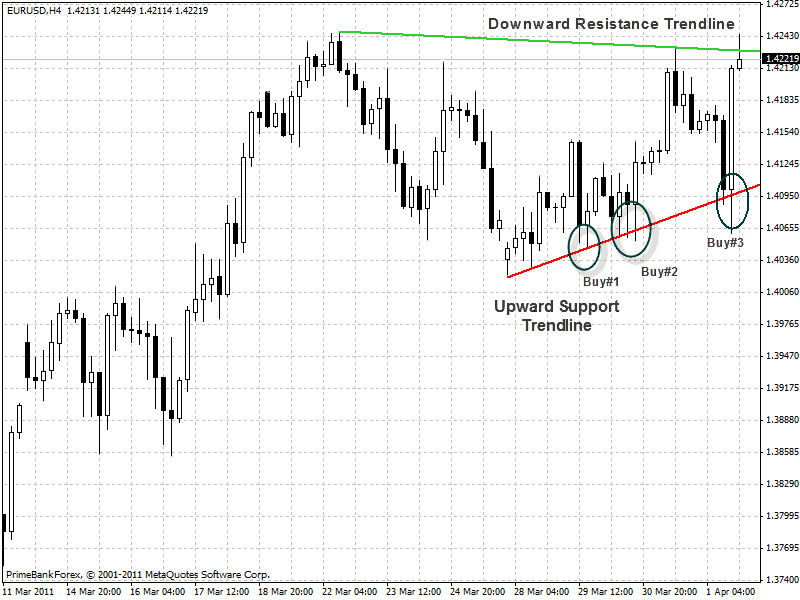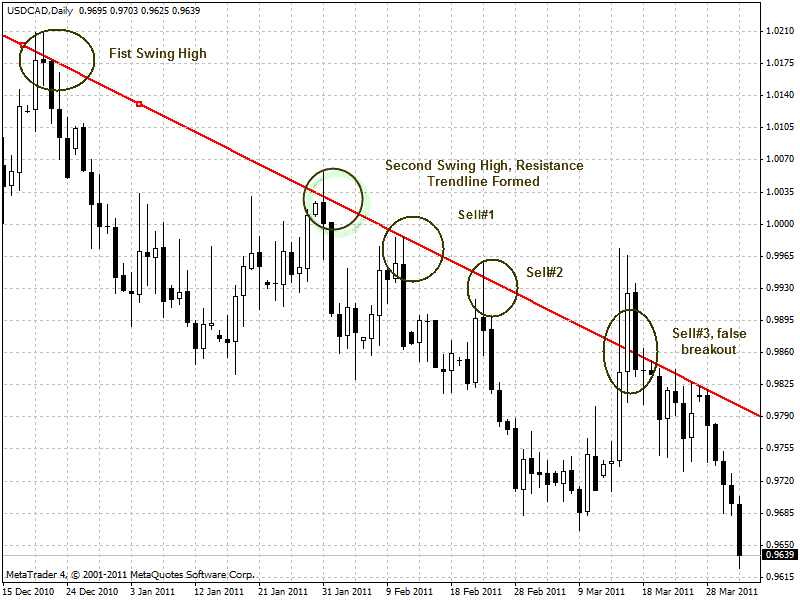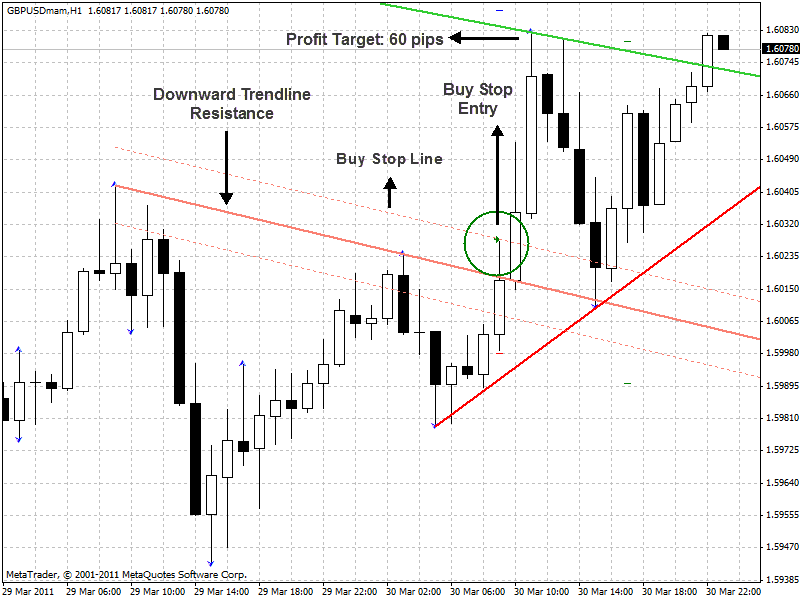What are the Best Forex Trend Indicators
Data is continually updated by our staff and systems.
Last updated: 17 Jul 2020
We earn commissions from some affiliate partners at no extra cost to users (partners are listed on our ‘About Us’ page in the ‘Partners’ section). Despite these affiliations, our content remains unbiased and independent. We generate revenue through banner advertising and affiliate partnerships, which do not influence our impartial reviews or content integrity. Our editorial and marketing teams operate independently, ensuring the accuracy and objectivity of our financial insights.
Read more about us ⇾
Trendline trading is a powerful method or tool to take advantage of numerous trading opportunities. Markets can trade horizontally, but they often trade diagonally, forming uptrends and downtrends. Trendlines are plotted along the uptrends and downtrends for the trader to quickly visualize the strength and slope of a given trend on a given timeframe, so he can enter in with the trend at retracement points or at breaks of the trend at trend reversals. In this article you can learn what are the best Forex trend indicators.
Table of Contents
It can be argued that some of the most profitable trading boils down to simple support and resistance trendlines and that all the numerous, complex mathematical indicators are just distracting clutter and noise that lags the market and slows trader reaction time in quickly market movements. The fact is, the market is run by the traders at the banks, and they are using trendlines (along with fundamental ideas of direction) more than indicators.
Thus, it behooves any trader to learn as much as he can about trendlines, how to plot them properly, and exploit them effectively.
There are a number of questions this article seeks to answer to help you become a better trendline trader:
- How to plot a trendline properly
- What timeframe to trade from
- What entry strategies can be exploited
- When to exit or be prepared to exit
How to Plot a Trendline?
We traders are always trying to find the trend, and plotting a trendline onto a chart is the easiest way for us to quickly see the currency’s direction. A trendline is a straight line that starts at the beginning of a trend and stops at the end of the trend. You can form one by hand using paper and pencil, but better yet, you can use MT4’s built-in trendline tool to plot your trendline. However, finding where to start and stop the trendline can be tricky, so we’ll help with how to spot them, plot them, and interpret them.
In general, we aim to start and stop the trendline at obvious highs and lows.
How to Plot an Uptrend Trendline:
Spot an obvious low and carry your eye along higher highs (tops) and higher lows to an obvious high. Take a look at the chart. The first line, starting from the left, starts at a low and ends at a high. In general, upward sloping trendlines are used to connect prices that act as support while the given asset is trending upward. This means that upward sloping trendlines are mainly drawn below the price and connect either a series of closes or period lows.
- Start at the lowest low and connect the line to the next low that precedes a new high.
- As long as the new highs are being made, redraw the line to connect to the lowest low before the last high.
- When prices start making new highs, stop drawing. Extend the line out into the future at the same slope.
The upward trendline illustrates the support line. It’s named support because you expect the line to support the price – traders won’t let the price fall below it.
How to Plot a Downtrend Trendline:
The next trendline is a downtrend. It starts at a high and goes to a low. In the case of a downtrend, your eye starts at an obvious high and follows successively lower highs and lower lows (bottoms) to an obvious low (known after the fact). A downward sloping trendline is generally used to connect a series of closing prices or period highs that act as resistance while the given asset is trending downward.
- Start at the highest high and connect the line to the next high that precedes a new low.
- As long as the new lows are being made, redraw the line to connect to the highest high before the last low.
- When prices stop making new lows, stop drawing. Extend the line out into the future at the same slope.
The downward trendline illustrates the resistance line. It’s named resistance because you expect the line to resist the price–traders won’t let the price go above it.
Note: For purposes of drawing trendlines, use the highs and lows, but don’t totally ignore the close. It is possible to get a wild random move that creates a spike high or spike low that isn’t consistent with the overall trend.
Trading the Price Bounce off the Trendline
This strategy offers numerous opportunities to get on board an ascending/descending trend at decent price levels. You have probably seen many pairs take off in one direction for a sustained period of time but have been too shy to get on board because of the fear that of getting in too late. You fear that you will get in at the moment of price correction, a correction that manages to take out your stops before the underlying trend kicks in again. This is a justifiable fear. You may also feel guilty of hopelessly watching many pairs make new highs or lows, unsure when to get in to take advantage of those big moves.
However, if you plot your trendlines correctly, you can take advantage of buying from the support and selling from the resistance.
Trading Strategy: Buying at the Upward Trendline Support
The more times that a low of the time frame touches the support line without crossing it, the more confidence you should have that it is a valid description of the trend. This is called a test of support and encourages buyers to buy more after the price passed the test.
Often traders engineer a test of support by selling the currency down to the support line to see if the support will hold. If you put on a new position above the support line, you might have to bear some damage when traders test support. Will buyers rush in to support the currency? The reason that this strategy can work so well is: if the support holds, traders who were selling become buyers, and the market can be propelled back upwards very fast.
The Entry Rule:
Buy when the low of the bar reaches within a predefined number of pips of the support trendline.
This predefined number of pips could be a fixed pip scenario (such as within 10 pips above the trendline, just to make sure you get in), or it could be based on a percentage of the Average True Range of the currency and time frame in question (such as 20% of the 12-period ATR).
Let us look at an example of a chart of EURUSD on H4 timeframe:

You can see that the trendline had begun to form on March 28 at the first significant low, and the next low had confirmed it. The third low, which I have named Buy #1, could have been a nice spot for traders to take up buy positions for a 50 pip gain, but for most traders it would have represented another confirmation point for the trendline support.
After that point held firm, trendline traders would have drawn and highlighted the support trendline above, and put in buy limit positions at Buy #2, taking the EURUSD from 1.4065 up to 1.4220 (+150 pips). At that point in time, it would have looked like the trendline would never be touched again, as it was so far above. However, on April 1, the traders had charged back to retest this trendline one final time, at Buy #3, and when it held firm once again, they jumped in to shoot up the market like a rocket back to its former highs, from 1.4065 to 1.4220 (+150 pips).
Setting the Profit Target Level:
It can be the nearest level of support or resistance according to Pivot Point Levels. Or it can be a simplified option of choosing a fixed target appropriate to the currency and time frame; for instance, on H1 time frame, 40 pips for EUR/USD and 60 pips for GBP/USD.
Setting the Stop Loss Level:
Exit the buy position when the low of the bar falls below the support trendline by a predefined number of pips.
This predefined number of pips should be based on the Average True Range (ATR) of the currency pair for that time frame. For instance, the 7-period ATR for the EUR/USD H4 chart above was 45 pips. Thus, in Buy #1 and Buy #2, you would have suffered very little DD (Draw Dawn) risk for the profit taken, as the trades bounced soon after touching the line.
However, in Buy #3, you may have taken your trade from the line at 1.4090, and you would have been in a 30 pip drawdown before it corrected back in your favor. If you had only a fixed 10-30 pip stop loss on your trade, you would have been stopped out just before the correction had occurred. The average true range method would have been enough wiggle room to keep you in the rubber band trade as it stretched as far it could go before snapping back.
The Risks of this Trading Strategy:
When any part of the price bar penetrates the line on the downside, support may have been broken, or the trendline becomes unreliable. If the move continues to the upside after the trendline is broken, the trendline becomes unreliable. A breakout is any part of the price bar penetrating a line that you drew on the chart. Some traders require that to qualify as a breakout, the bar component that breaks the line has to be the close. Sometimes the offending breakout is quickly roped back into the herd, but usually a breakout means that the trend is changing direction, either right away or sometime soon.
Trading Strategy: Selling at the Downward Trendline Resistance
The more times that a high of the time frame touches the resistance line without crossing it, the more confidence you should have that it is a valid description of the downward trend. This is called a test of resistance and encourages sellers to sell more after the price passed the test.
Just as traders engineer a test of support, they engineer a test of resistance. You are hoping that the sellers will rush in to hold the resistance line, and if the resistance holds, traders who were buying will become sellers.
The Entry Rule:
Sell when the high of the bar reaches x number of pips of the resistance trendline.
Let us look at an example of a recent chart on the USDCAD on the D1 time frame:

What you don’t see in the chart above is that the USD/CAD has been in a steep downtrend since March, falling from 1.26910 to 0.96435. The downtrend on the chart above was started for this year only. It starts with a swing high on Dec 20, and gets the second swing high on Jan 31, which allows forming the downward trendline resistance.
Trendline traders would have drawn the same trendline and taken short positions at the approximate area of the trendline. The first short position (Sell #1) came at Feb 10, at 0.9985, and it allowed traders to dive down to 0.9825 (+100 pips). The second short position (Sell #2) followed in the same month at 0.9958 and allowed traders to take the market to an even greater low of 0.9666 (+300 pips). The third short position (Sell #3) came on March 15, and it would have been much trickier to stay on board with this one without getting stopped out.
One would have entered around 0.9874, and the market had jumped up to a high of 0.9973, which would have meant you would need a greater than 100 pip stop loss to still be in the game. If you had managed to be still in the game, you would have seen the market fall lower to 0.9643 (+330 pips).
Setting the Profit Target Level:
It can be the nearest level of support or resistance according to Pivot Point Levels. Or it can be a simplified option of choosing a fixed target appropriate to the currency and time frame; for instance, on H1 time frame, 40 pips for EUR/USD and 60 pips for GBP/USD.
Setting the Stop Loss Level:
Exit when the high of the bar reaches above the resistance line by a predefined number of pips.
As mentioned before, I prefer an average true range based on the currency and time frame in question than a fixed stop. In either case, you would have been able to take Sell #1 and Sell #2 with very little open DD, as the trades touched the line before descending. However, even if you had put the 7-period ATR of the USD/CAD, which was 60 pips at that time, you would have been stopped out on Sell #3. Only a fixed stop of 100 pips or more would have let you survive that trade. Sell #3 was very tricky, and only the more veteran trendline traders would have had the balls to jump back in after being stopped out.
Note: the breakout traders would have seen the USD/CAD penetration of March 15 trendline as an opportunity for a breakout, and they too would suffer from this trade as it would prove to be a fake breakout (more on that later).
The above strategy helps traders enter or stay in a trend. The trading mistake is staying in the trend after the trendline is broken. Sometimes new traders will be resistant to take a loss, and they keep giving the trade more wiggle room, hoping it comes back. They may even draw in new, flatter trendlines, hoping the market stays bound by them. However, a trader should always remember that if the reason for staying in the trade is no longer valid, it is the trader’s job to take a small loss and move on to the next trade.
Trading the Breakout / Breakdown of Trendlines
While the previous strategy seeks to enter on bounces from the trendline, this strategy seeks to enter on breakouts/breakdowns of the trendline. All traders should be prepared for both the bounce and the break. It is a matter of keeping your mind and eyes open to both possibilities, which can be harder than it seems. Usually, when we trade for a specific direction, we develop a psychological bias for that direction, and we are reluctant to swing 180 degrees around and take a trade in the opposite direction. It would be ideal if we were so flexible, though usually what takes place is that we side with one method or the other.
Trading the breakout/breakdown of the trendline has been given more credence than the bounce, particularly as it has been used effectively by veteran traders, and written about intensively by famous technicians like Tom DeMark.
Trading the breakout/breakdown of the trendline can be very powerful because when the trendline breaks, it represents a reversal from the trend of that timeframe, propelling the market to stretch back to its nearest resistance or support, which can be sometimes very far away, depending on how far up or down the market had trended.
That being said, it is always safer to take a breakout/breakdown on a lower interval time frame in the direction of the trend that remains firm in the higher interval time frame. For instance, if the daily or H4 time frame is strongly bullish, you would want to place a buy stop for a breakout through a downward trendline taking place on a H1 or M30 time frame. That way you will be trading with the larger trend current, which would give you a better edge than otherwise.
To get the Right Setup:
Draw a downtrend trendline or uptrend line using the rules drawing trendlines discussed above. Choose a timeframe that illustrates the setup with the best slope, with preference given to higher timeframes over lower ones. Try to look for breakout/breakdown in direction of a larger trend, but keep in mind that opportunities exist in breakouts (reversals) of the larger trend itself.
The Entry Rules:
The entry is done on the breakout of the downward trendline or the breakdown of the upward trendline by a predetermined number of pips. The predetermined number of pips should be appropriate for the currency volatility and time frame. Usually, a break of the trendline by 10 pips should be sufficient.
Example of GBPUSD on H1:

The above chart, plots the trendlines on the GBP/USD H1 chart at around 3:00 am on March 30. You can see a very interesting downward trendline resistance had formed on two swing highs (solid red line). Since the larger trend was up, it was chosen to have a buy stop entry 10 pips above the trendline (dotted red line), which was hit at 7:00 am on March 30. Three bars later it hit 60 pip profit target.
Setting the Profit Target Level:
It can be the nearest level of support or resistance according to Pivot Point Levels or it can be a simplified option of choosing a fixed target appropriate to the currency and time frame; for instance, on H1 time frame, 40 pips for EUR/USD and 60 pips for GBP/USD. You may even want to experiment with timeouts, counting the number of candles before the target is reached, and if it is not reached in x number of candles, you close out the trading positions.
Setting the Stop Loss Level:
You can have it a couple of different ways. You can put a protective stop just above/below the candle that broke through the trendline. Or you can determine a stop loss that is the 7-period average true range of the currency and time frame in question. Or you can put a fixed stop loss appropriate to the currency and time frame; for instance, on H1 time frame, 30 pips for EUR/USD and 40 pips for GBP/USD.
The Risks of Trading Trendline Breaks:
A trendline breakout doesn’t necessarily lead to the formation of a trend in the opposite direction. Sometimes it can lead to a resumption of the same trend. A move upward that occurs after the first breakout above the resistance line is called a retracement, correction, or pullback. At the time it is occurring you don’t know whether it is a full trend reversal or just a retracement. It is thus always wise to employ a stop loss.
A one or two bar break of the line that reverts back to the trend is called a false breakout. It is called false because it proves false your conclusion that the breakout will continue on the path of a trend reversal, when in fact it is just baiting to lure the breakout traders into a losing trade that ultimately reverts back to the trend.
Traders have discussed different ways of confirming the validity of the breakout. One method is to wait for the close of the breakout bar; if the close is above the downward trendline, it helps to confirm the breakout. The downside to this confirmation is that it forces you to get in on the trade later, and thus miss part of the move.
Alternatively, master trader Larry Williams recommends that one consider the position of the close of the day before the breakout. If one is trying to work a buy breakout, and if the close is at or near the high, chances are good that it’s a false breakout; if the previous day was a down close and then broke out, chances are the breakout is real and the market will go higher.
The downside to William’s confirmation is it forces you to doubt the breakout potential of bars that had a preceding bar close near its high, and thus you might miss out on breakout opportunities that proved genuine despite William’s prediction.
Thus, a filter for the close of the breakout bar or the preceding bar can cause traders to miss part or all of the breakout move, and it is sometimes best to trade without such filters, knowing ahead of time that the breakout can ultimately be a false breakout (and resumption of current trend), and that is why you are using stop losses.
Wrap Up
Ideally, once you have mastered how to draw good trendlines by hand or via automated indicators, you can zoom in and out on multiple time frames, searching for the time frame where it looks like traders are lining up to support a downward trendline support or an upward trendline resistance.
To better determine if you should be taking bounces or breaks from these identified trendlines, you should be first familiar with the trend taking place on the larger time frame.
If the technical and fundamentals suggest that the larger trend is up, you would best to look for bounces from upward trendlines or breakouts from downward trendlines on smaller time frame intervals. If the technical and fundamentals suggest the larger trend is down, you would best to look for bounces from downward trendlines or breakdowns from upward trendlines on smaller time frame intervals.
Every once and while there is a break or bounce from a daily time frame itself, and if a definite break occurs, you should be prepared to switch gears; that is, if you were formerly bearish, you will become bullish, and vice-verse.
The daily bar break is a powerful break, and a lucky opportunity if you can find it. However, if you miss the initial breakout of the daily bar, you can always play the retest, the pullback to the support or resistance bar that was just broken, allowing traders who did not get in on the initial breakout a second chance to get in. You would then have the benefit of having former support become resistance, and the former resistance becomes support.
Once the new trend continues, you can always take advantage of the bounces or breaks on smaller time frames in the direction of the new trend until the next breakout/breakdown of the daily trend.
Trendline trading thus illustrated calls for the instincts of a hunter, inclining one to follow the path of the big game (the larger trend), at the same time tracking the zigs and zags of different time frames, trading with the herd on the bounces from “strong” trendlines, and setting traps (stop entries) on the breakouts of “weak” trendlines that dare to counter the larger trend.


